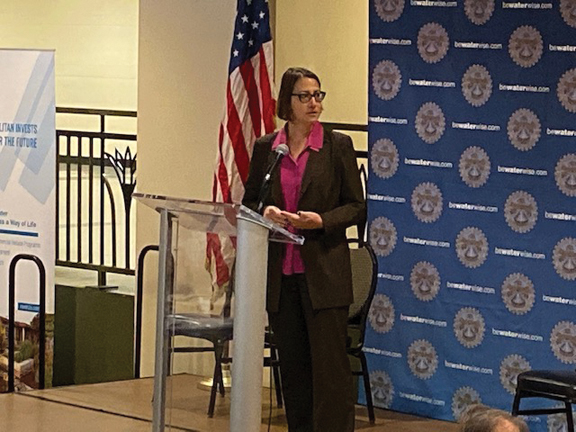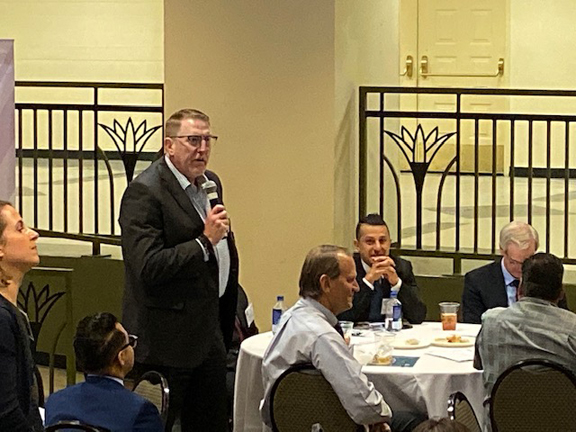
Assemblymember Laura Friedman spoke on California’s water supply during a presentation by Metropolitan Water District and local agencies.
By Mary O’KEEFE
The history of California water has inspired books and screenplays. It has been the foundation of epic political battles, land grabs and has even pitted the state’s northern region against the southern.
A talk on water and how the state will be moving forward in this changing climate was held this week by Assemblymember Laura Friedman. The event was attended by representatives from Metropolitan Water District and Burbank and Glendale water agencies, including Glendale City Councilmember and Metropolitan Water District director Vartan Gharpetian.
“Metropolitan Water District is a pretty amazing agency,” said Jeff Kightlinger, MWD general manager. “What we are is the regional water wholesaler for Southern California.”
MWD coverage encompasses parts of six counties, including Ventura, Orange and Los Angeles.
“One in every two Californians live in Southern California. That translates to one in every 17 Americans,” Kightlinger said.
That is a lot of the population that is covered by MWD.

Kightlinger acknowledged that Southern California has many challenges, from crime to housing.
“And water is one of [the challenges],” he said. “We do not, simply put, have nearly enough water for Southern California. So we have gotten very creative … In the 1900s, the City of Los Angeles went up to Owens Valley and developed a 300-mile aqueduct that was entirely gravity-fed because they didn’t have pumping systems in the turn of the century.”
By the 1930s, due to California’s growth, the state ran out of water again. Thirteen cities, including Glendale, Burbank and Pasadena, got together and formed the MWD as a source to pool water resources, he added.
This led to a bond measure to build the Colorado River Aqueduct from 1933 to 1941. It stretches 242 miles from the Colorado River on the California and Arizona border to a holding reservoir near Riverside.
Then in the 1960s the state ran out of water again due to population growth. Led by then-Governor Pat Brown, the state built the biggest public works structure in the nation at the time called the State Water Project, Kightlinger said.
With this project MWD agreed to a 75-year repayment plan, which continues through 2035, to pay half the costs of the project.
In 1990 California faced another water shortage.
“So you start seeing the pattern. Every generation we have a [water shortage],” he said.
At that point it was obvious the state could not continue to build bigger and more costly water projects.
“At that time we realized we had to reinvent ourselves,” he said.
Until the 1990s local cities had their own water planners. After the 1990s MWD became a regional planner to help guide the area as a whole. In 1995, MWD created a 25-year Integrated Resources Plan for the future. That plan will be revisited in 2020.
Kightlinger added that although Southern California’s population has continued to grow the use of water has been reduced through conservation, including the implementation of low flow toilets and water-efficient appliances.
MWD is working to upgrade its Integrated Resources Plan and looks toward new projects in the future including building an ambitious water recycling plant.
A lack of water is not only a concern for Southern California but also for central and northern California. Assemblymember Friedman said the state assembly is looking at solutions for the entire state.
She added there are areas of California that have an ample supply of water so there is no urgency to conserve, while other areas focus on various ways to conserve water. An examination of water needs across the state is necessary.
“[We discovered] a few years ago that farmers of Central Valley and elsewhere were drawing so much from ground water they were causing the central part of the state to sink into the ground,” Friedman said. “And once that ground water, the underground aquifers, collapse it’s like a water bottle that gets squeezed.”
Friedman added that water is not a resource that can be easily replenished.
Climate change and its effect on water supply is also a concern.
“Our snow has become water,” Kightlinger said referring to the smaller snow pack in the High Sierra and less snow in the Rockies.
MWD is working with officials like Friedman and the Governor in efforts to keep the water flowing in Southern California.
